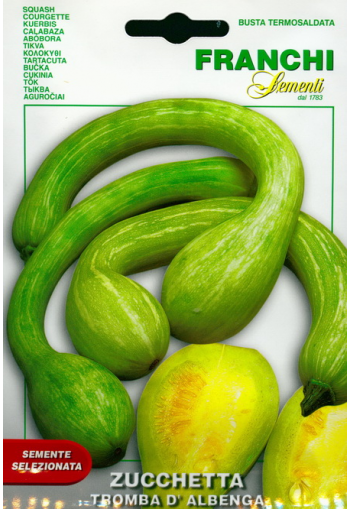Ex Tax: 1.35€
Long, intricately twisted fruit: delicious and aromatic, with bright yellow flesh and a very small seed nest.
It can be stored for more than a year without losing quality. Medium early variety: ripening on the 100-105th day after germination.
The average fruit weight is 6-8 kg. Due to the high sugar content, the culinary use of this variety is simply unlimited:
puddings, cakes, pastries, candied fruits are made from it ...
Moreover, such unusual fruits are a true decoration of both the garden and the house.
So far, you can meet Crookneck in our gardens only from lovers of rare vegetable crops.
And it's a pity, because this younger brother of the marrow, covered with "warts", is not only intricately beautiful, but also tasty, juicy, tender and healing.
"Twisted neck" is a type of hard-bore pumpkin.
The Crookneck grows as a bush and reaches a height of 50-70 cm. Its leaves are large, heart-shaped or pentagonal, with dark green longitudinal stripes on the petioles
(by this feature, they can be easily distinguished from the leaves of a squash).
The flowers are large yellow bells. The fruits of the crooknek are club-shaped or pear-shaped, curved or intercepted at the peduncle
(yellow, cream, white, bronze, golden or orange, with many tubercles-warts on the surface of the peel).
Crookneck begins to bear fruit a little later than the vegetable marrow - from mid-July and yields the harvest until the first frost.
Remove its fruits until they turn yellow, since overripe fruits form a very hard peel.
Despite the unsightly appearance, the fruits of crookneck are more nutritious and healthier than zucchini. Their taste combines the sweetness of a pumpkin and the neutrality of a squash.
Soft and tender, but denser than zucchini, the flesh of the crooknek is suitable for drying, marinating and frying.
Crooknek is eaten fresh, stewed and stuffed. In cooked dishes, it does not creep like zucchini.
In general, the agricultural technology of crooknek is no different from the cultivation of marrow. But he is more thermophilic.
Crookneck seeds begin to germinate at a temperature of + 14 + 15 ° С, and the optimum temperature for the development of their bushes is + 25 + 28 ° С.
Even with the shortest frosts, the plant dies. In addition, crookneck does not tolerate strong fluctuations in daily temperatures.
With prolonged cool weather, the leaves of the plant turn pale, the formation of ovaries stops.
Therefore, in the conditions of Estonia and more northern regions, it is better to grow kruknek through seedlings.
At the end of May, at the age of 25-30 days, it is planted in a garden bed and covered with two layers of non-woven covering material on top.
The crookneck requires more space than the spray zucchini, approximately 1.5 x 1.5 m.
Like a cucumber, a croocknek bed is insulated with a "pillow" made of organic compost, which will provide additional warmth on cool nights.
As soon as the first flowers open, the shelter is removed. If there are only barren flowers on the bushes, the top of the head is pinched off at the main lash, more female flowers are always formed on the lateral lashes that have grown as a result. To improve illumination, old leaves are cut out in the middle of the bush and shoots that have no fruit are removed.
When growing crookneck, there is one more important point: it must be watered with warm water, otherwise diseases and plant death cannot be avoided.
The fruits of the crookneck are located at the base of the bush, and in order to harvest, you have to reach under the leaves, bending around the stems.
There are small thorns on the leaves and stems, therefore, in order not to scratch your hands, it is better to harvest crooknek with gloves.











